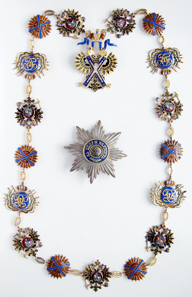The Imperial Order of St. Andrew the Apostle the First-Called
The Imperial Order of St. Andrew the Apostle the First-Called is the oldest of Russian orders. It was established by Tsar Peter I on 30 November / 10 December, 1698, in honor of St. Andreas, the patron saint of Russia. This Apostle was given the epithet the First-Called because John the Baptist advised him to turn to Jesus, and Andreas consequently became the first disciple of Jesus. This epithet bears a little stinger against Rome and St. Peter. After all, it took his brother Andreas to make St. Peter conscious that there was somebody called Jesus.
Carel de Moor, Portrait of Peter the Great, 1717.
Back to the newly founded order: 1698 was the year when Peter the Great had to abort his travel throughout Europe because of the Streltsy Uprising. They opposed Russia’s modernization following the European model. Only their radical annihilation paved the way for Peter to both enact new laws and introduce new customs. This is the context in which the first Russian chivalric order was instituted to make the best to commit themselves to the Tsar, following the Western model.
Hall of the Order of St. Andrews in the Moscow Kremlin. Painting by Konstantin Andreyevich Ukhtomsky (1818-1881).
The Western order system had made a lasting impact on Peter the Great. He personally participated in the ceremonies involved in the awarding of the Order of the Garter in England as well as the Order of the Golden Fleece in Vienna. Until then, the Russian tsar used to reward good services with estates or gifts only. An order of one’s own offered much bigger chances to channel loyalties.
Insignia of the Imperial Order of St. Andrew the Apostle the First-Called, consisting of collar (2nd model 1857-1917, made of seven eagles, six St. Andrew’s Crosses and four monogram limbs), jewel (2nd model 1857-1917, made of seven eagles, six St. Andrew’s Crosses and four monograms 1856-1917) and breast star (4th model, 2nd execution). All stored in the original awarding casket, slightly worn, gold imprinted. Extremely rare. Condition I-II. Estimate: 750,000 euros.
Peter the Great created only one single class of the Imperial Order of St. Andrew the Apostle the First-Called as the highest Russian decoration. That later resulted in the order being conferred only on persons who held the rank of Lieutenant General and who had already been rewarded more than once.
Alexander III wearing the coronation robes, with the Collar of the Imperial Order of St. Andrew the Apostle the First-Called around his neck.
Hence, the circle of this order’s recipients consisted exclusively of people of the very high and the highest caliber. Before speculating about the identity of the wearer of the insignia now being offered at Künker’s, one has to reflect upon the date on which it had been created.
The punches used to mark the individual pieces provide a hint. Thanks to these punches we know that the conferral of the order cannot have taken place before 1903.
After having spent much effort on research, Michael Autengruber, i.e. the writer of the auction sale catalog on orders, is convinced that the laureate must have belonged to the Romanov family. According to the order’s register, the award was conferred on just four members of the royal family after 1903.
- Tsarevich Alexei Nikolayevich who was killed together with his family and whose orders surely remained in Russia
- Prince Gabriel Konstantinovich, great-grandson of Tsar Nicholas I
- Vasili Alexandrovich, nephew of Tsar Nicholas II
- Roman Petrovich, likewise a great-grandson of Tsar Nicholas I
The owner of the order’s insignia could only have been one of the latter three. Admittedly, they all had intriguing fates.
Gabriel Konstantinovich was freed from prison, with the aid of Maxim Gorki, and managed to flee to Paris.
Vasili Alexandrovich was on vacation on Crimea when the Russian Revolution broke out, and was able to escape on board of a British battleship. Afterwards, Vasili Alexandrovich spent the rest of his life in California.
Roman Petrovich was on the same battleship as Vasili Alexandrovich. He chose the French Cap d’Antibes as his new home which he did not even leave when he was offered the crown of Montenegro in 1941, which regained its strength under Italian occupation.
Roman Petrovich is the only family member with descendants, including Nicholas Romanovich (*1922), today the legitimate head of the House of Romanov.
No matter which member of the Romanov family had actually worn these order’s insignia, the precious items remind us of a bloody chapter in the Russian past. Künker reckons that this unique lot will attract huge interest particularly in its native country and hence is likely to return home after these many years.
Postscriptum:
On the occasion of the 300th anniversary of the order’s establishing, Boris Yeltsin reinstated the Order of St. Andrews on 1 July, 1998. Among its modern recipients are Alexander Solzhenitsyn (1918-2008), Mikhail Gorbachev (*1931) and Mikhail Kalashnikov (1919-2013), inventor of the machine gun bearing his name.
You can find the complete auction catalogue online.
You can read a preview of this auction here.













